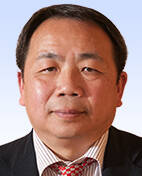The first study to methodically calculate how much food blue whales and some of their close relatives eat has yielded a simple answer: a whole lot.
The blue whale, the largest animal in Earth’s history, eats about 16 tonnes of krill daily in the North Pacific, gobbling up these tiny shrimp-like crustaceans with a filter-feeding system in their mouths using baleen plates made of keratin, the substance found in people’s fingernails, scientists said on Wednesday.
“That is roughly the weight of one fully loaded school bus,” said study coauthor Nick Pyenson, curator of fossil marine mammals at the Smithsonian Institution’s National Museum of Natural History in Washington.

Photo: AFP / Stanford University
The researchers calculated daily food intake for seven baleen whale species, tracking 321 individual whales in the Atlantic, Pacific and Southern Oceans from 2010 to 2019. These gigantic marine mammals were found to eat up to three times more food than previous estimates that were based on stomach contents of hunted whales or extrapolations from smaller marine mammals.
The other species studied — humpback, fin, bowhead, right, Antarctic minke and Bryde’s whales — also devoured impressive amounts. North Pacific Humpback whales can eat 9 tonnes of krill daily, while fin whales consume 8 tonnes.
“It is an unimaginable amount of food, but large whales are themselves unimaginable. A blue whale is the size and weight of a Boeing 737,” said Stanford University marine biologist Matthew Savoca, who is lead author of the study published in the journal Nature.
Blue whales, larger than even the biggest dinosaurs, can reach 33m long and 200 tonnes.
The researchers determined how often each whale engaged in feeding behavior using electronic tag devices suction-cupped to the animal’s back, with a camera, microphone, GPS locator and an instrument that tracks movement. Drones were used to estimate the size of a whale’s mouth area and how much prey it could engulf. An acoustic method measured nearby prey biomass.
Baleen whales eat zooplankton: small prey including krill, fish or crustaceans called copepods. The largest species prefer krill. Smaller species such as humpback, Bryde’s or minke whales can eat schooling fish or krill.
Most baleen whales do not eat year-round, having a feast-or-famine annual cycle. They eat about 100 days annually, typically during a summer breeding season, while eating little the rest of the year. Based on eating 16 tonnes in a day, the blue whale would consume perhaps 1,600 tonnes annually.
Food intake varied based on species, location and prey type. Among three humpback populations studied, North Pacific krill specialists consumed 9 tonnes daily, North Pacific fish eaters 3.5 tonnes and Southern Ocean krill specialists 3 tonnes daily.
Among the other species, Arctic bowhead whales consumed 6 tonnes daily of copepods, North Atlantic right whales 5 tonnes of copepods, South Atlantic Bryde’s 1 tonne of fish and Southern Ocean minke 0.69 tonnes of krill.
As the whales eat more than previously known, they also produce more excrement, an important ocean nutrient source. By catching prey and defecating, they help keep nutrients suspended near the sea surface to generate blooms of carbon-absorbing microscopic organisms called phytoplankton that form the base of marine food webs.
Pyenson said the study’s calculations suggest that before baleen whale numbers were dramatically reduced by 20th century industrial whaling, they had consumed more food than all of the world’s current krill biomass and global fisheries combined.
“The implication of these numbers is that whales supported far more productive ocean ecosystems before whaling, and that promoting whale recovery in the 21st century may restore ecosystem functions lost in the past hundred years,” Pyenson added.

LANDMARK CASE: ‘Every night we were dragged to US soldiers and sexually abused. Every week we were forced to undergo venereal disease tests,’ a victim said More than 100 South Korean women who were forced to work as prostitutes for US soldiers stationed in the country have filed a landmark lawsuit accusing Washington of abuse, their lawyers said yesterday. Historians and activists say tens of thousands of South Korean women worked for state-sanctioned brothels from the 1950s to 1980s, serving US troops stationed in country to protect the South from North Korea. In 2022, South Korea’s top court ruled that the government had illegally “established, managed and operated” such brothels for the US military, ordering it to pay about 120 plaintiffs compensation. Last week, 117 victims

China on Monday announced its first ever sanctions against an individual Japanese lawmaker, targeting China-born Hei Seki for “spreading fallacies” on issues such as Taiwan, Hong Kong and disputed islands, prompting a protest from Tokyo. Beijing has an ongoing spat with Tokyo over islands in the East China Sea claimed by both countries, and considers foreign criticism on sensitive political topics to be acts of interference. Seki, a naturalised Japanese citizen, “spread false information, colluded with Japanese anti-China forces, and wantonly attacked and smeared China”, foreign ministry spokesman Lin Jian told reporters on Monday. “For his own selfish interests, (Seki)

Argentine President Javier Milei on Sunday vowed to “accelerate” his libertarian reforms after a crushing defeat in Buenos Aires provincial elections. The 54-year-old economist has slashed public spending, dismissed tens of thousands of public employees and led a major deregulation drive since taking office in December 2023. He acknowledged his party’s “clear defeat” by the center-left Peronist movement in the elections to the legislature of Buenos Aires province, the country’s economic powerhouse. A deflated-sounding Milei admitted to unspecified “mistakes” which he vowed to “correct,” but said he would not be swayed “one millimeter” from his reform agenda. “We will deepen and accelerate it,” he

Japan yesterday heralded the coming-of-age of Japanese Prince Hisahito with an elaborate ceremony at the Imperial Palace, where a succession crisis is brewing. The nephew of Japanese Emperor Naruhito, Hisahito received a black silk-and-lacquer crown at the ceremony, which marks the beginning of his royal adult life. “Thank you very much for bestowing the crown today at the coming-of-age ceremony,” Hisahito said. “I will fulfill my duties, being aware of my responsibilities as an adult member of the imperial family.” Although the emperor has a daughter — Princess Aiko — the 23-year-old has been sidelined by the royal family’s male-only